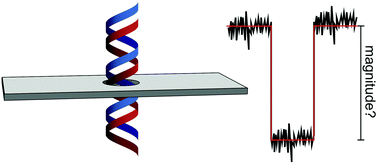Understanding and modelling the magnitude of the change in current of nanopore sensors†
Abstract
Nanopores are promising sensing devices that can be used for the detection of analytes at the single molecule level. It is of importance to understand and model the current response of a nanopore sensor for improving the sensitivity of the sensor, a better interpretation of the behaviours of different analytes in confined nanoscale spaces, and quantitative analysis of the properties of the targets. The current response of a nanopore sensor, usually called a resistive pulse, results from the change in nanopore resistance when an analyte translocates through the nanopore. This article reviews the theoretical models used for the calculation of the resistance of the nanopore, and the corresponding change in nanopore resistance due to a translocation event. Models focus on the resistance of the pore cavity region and the access region of the nanopore. The influence of the sizes, shapes and surface charges of the translocating species and the nanopore, as well as the trajectory that the analyte follows are also discussed. This review aims to give a general guidance to the audience for understanding the current response of a nanopore sensor and the application of this class of sensor to a broad range of species with the theoretical models.



 Please wait while we load your content...
Please wait while we load your content...